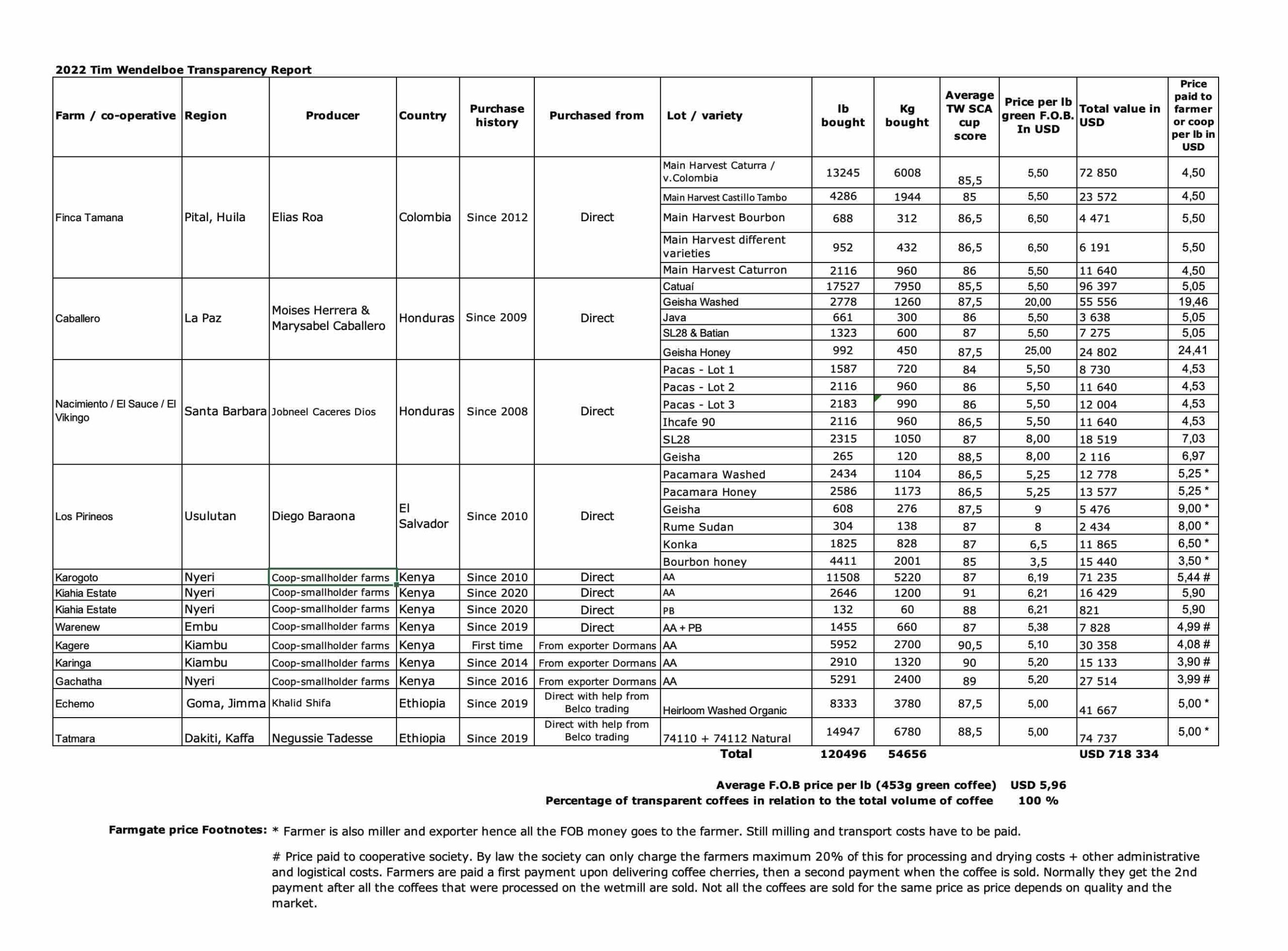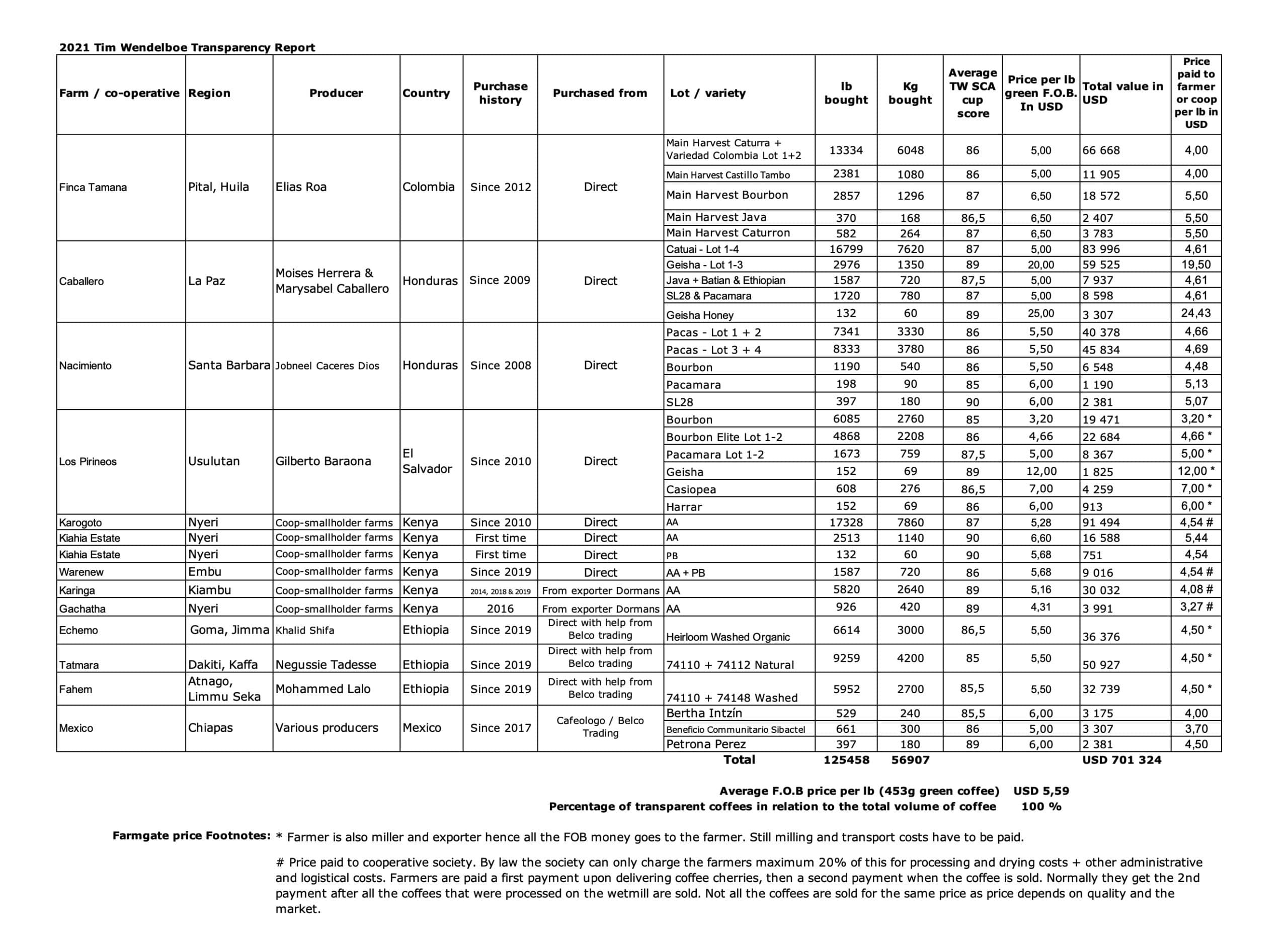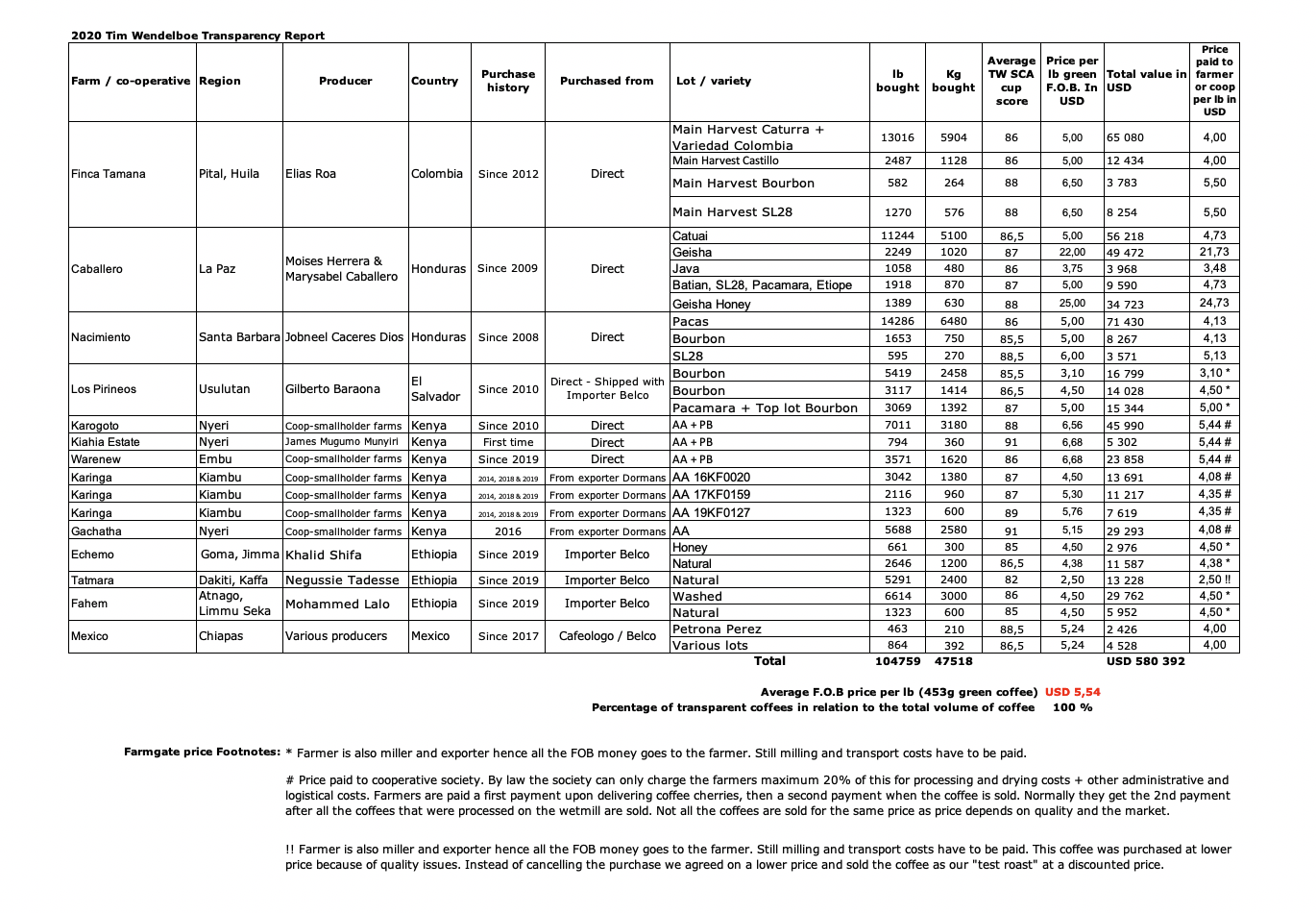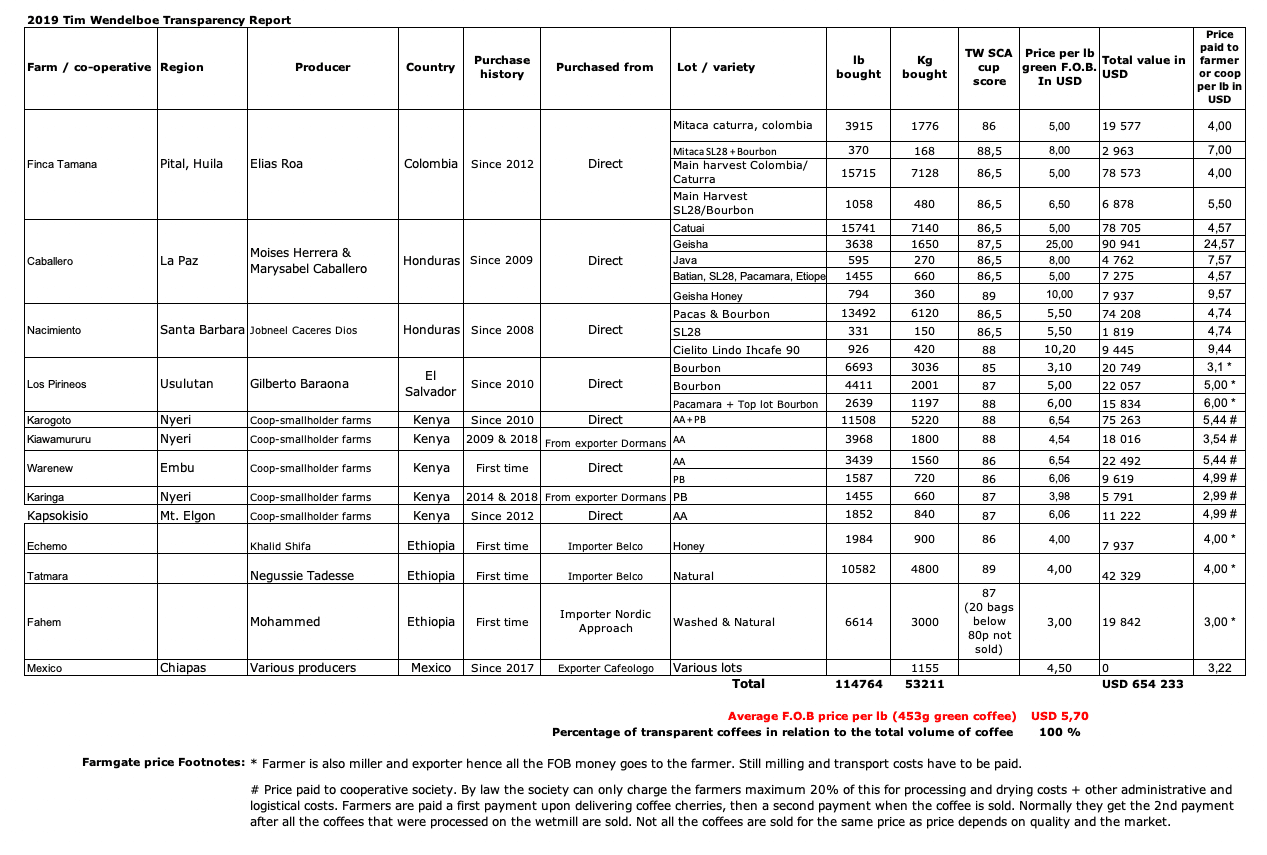Transparency and coffee prices
Yesterday I got a link sent to me by a good friend and coffee enthusiast in San Francisco. The link is to an Internet forum called Home Barista that is basically a discussion forum for coffee enthusiasts from around the world. I was a bit surprised to read this post on a forum created by and for coffee lovers, so I felt I had to reply in order to educate our customers and also to try to explain that not all coffee companies are the same.
Transparency
A lot of high quality driven roasters, including ourselves, preach that transparency is the most important part of our trade, but rarely do we actually get to see the numbers in the coffee industry. Sustainable Harvest is one of the few companies that are trying to do something about this through their Relationship Information Tracking System. Cup of Excellenceis also a great example of where consumers can get full traceability of the coffee trade. I have been trying to establish a traceability system of our own and also to develop a contract that shows what the farmer gets when we pay USD 3 pr. lb (453g) FOB for coffee. We do have the contracts in Kenya as this is cooperative coffees created by hundreds of farmers. For all the other coffees we have bought this year we feel we don’t need it as we are communicating directly with the farmers anyway. We are still far away from being 100% transparent but hopefully in the future we will be able to get a system for it that enables our customers to get all the info they need. As a temporary solution I have started to systemize all the information about our coffee purchases from the end of last year, and to my surprise we are actually paying a higher average price for our coffee than I thought we were.
Coffee prices
For the past months we have read that the C market price for coffee is at it’s highest in over 10 years at about USD 1,6 pr. lb. (453 g) of green coffee. Although this is not a very high price for coffee it is still very positive that it is going up, as the price has been way too low for the last 10 years, forcing a lot of producers to start growing other cash crops in order to survive. As you all probably know, we do not trade coffee based on the C market price and we do not sign future contracts based upon today’s prices like most of the bigger roasteries do. We buy the coffee direct from exporters or farmers and negotiate the price based on taste and quality. We negotiate with the farmer and the exporter. Not with a broker. We also have gentlemen’s agreements with farmers that if they continue their work with quality, we will be there to support them by buying their coffees.  As promised, I will try to do an effort for transparency, so here are the prices in USD pr. lb that we have payed for our coffees FOB (free on board) in 2010: Panama, Hacienda la Esmeralda:______ 26,50 $ + packing Honduras, Cielito Lindo 2010 COE:_____ 8,10 + packing El Salvador, Las Palmas 2010 COE:_____ 5,31 + packing Honduras, Naciemento:______________ 3,50 Honduras, Finca El Pantanal:___________3,00 Guatemala, Santa Ana:_______________ 3,50 Kenya, Mugaga:_____________________ 4,77 Kenya, Tekangu:____________________ 5,23 Of course these lots are not the same size. The Esmeralda was only about 120kg for instance. So the average price per lb. so far this year is actually USD 5,06.
As promised, I will try to do an effort for transparency, so here are the prices in USD pr. lb that we have payed for our coffees FOB (free on board) in 2010: Panama, Hacienda la Esmeralda:______ 26,50 $ + packing Honduras, Cielito Lindo 2010 COE:_____ 8,10 + packing El Salvador, Las Palmas 2010 COE:_____ 5,31 + packing Honduras, Naciemento:______________ 3,50 Honduras, Finca El Pantanal:___________3,00 Guatemala, Santa Ana:_______________ 3,50 Kenya, Mugaga:_____________________ 4,77 Kenya, Tekangu:____________________ 5,23 Of course these lots are not the same size. The Esmeralda was only about 120kg for instance. So the average price per lb. so far this year is actually USD 5,06.
Adding to the cost
As you may know, this is just for the green coffee. We also need to pay for the shipping and handling of the coffee before it gets to our roastery. Shipping cost can vary greatly depending on the origin of the coffee. The price of the coffee gets about 25 to 30 % higher for the coffee when we include these costs. On average this means the price for the coffee when it has arrived to Norway is about USD 6,58 pr.lb. We also need to cover our travel expenses that we spend when we travel around the world to find these coffees and visit the producers. So far this year I have been to Kenya and Honduras, and I am going to Brazil next week, to Colombia in October and visiting Kenya again in November. That adds up to 60 days of traveling and a cost around NOK 120.000,- or about USD 20.200,- only for 2010. My accountant may think I am crazy spending so much on traveling, but I think it is totally necessary and a good investment for the future. We are building relationships with serious farmers and we are trying to secure a good supply of great coffees in the future. We want to develop long term relationships with the farmers, not have one night stands with them. After the coffee has arrived to Norway we still need to roast it, so you have to add the cost of production, rent needs to be payed as well as salaries, delivery truck, electricity, maintenance, etc, etc. Of course the cost of living is higher in Norway than in Colombia and therefore we need to add a bigger margin to the coffee than a farmer in a producing country needs in order to make a living. For example, a beer in Colombia is about 1 USD. In Norway a beer in a bar is about 10 USD.
Is coffee expensive?
Some people think our coffees are expensive, and I understand that they believe so, especially if they compare us to a coffee sold in a supermarket. But if you taste the difference and understand how much work and effort is behind these coffees, I still believe that our coffees are cheap. It all boils down to about NOK 5,- or about USD 0,9 pr. cup. Compare that to what you pay for a bottle of water here in Norway (USD 5) where we have plenty of super clean water free from the tap, I think there is no need to discuss whether coffee is expensive or not.
Why is some coffees worth more than others?
Because quality of the coffee varies. Not only from farm to farm but within the same farm we can sometimes find a huge range of different qualities and varietals. 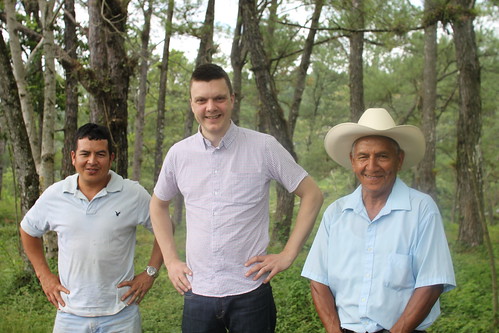 Take Cielito Lindo and Naciementofor instance. These 2 farms are neighbouring farms run by father and son. They grow coffee from 1500 to 1800 masl. in 2 very different types of soil. They grow 5 different Arabica varietals (Pacas, Catuai, Catimor, Geisha and Bourbon) These trees produce (like all other fruit trees) both very mature coffee cherries and also unripe and cherries that fall to the ground and get mouldy and rotten. Of course this will produce coffee of different quality. Next year we will be there during their harvest in order to help them separate the different varietals. We are going to taste the coffees blind and score them according to the COE cupping form. We will pay more for the better tasting lots and less for the lots that get lower scores. Would we do this if there wasn’t a difference? I think not. So, why do we do this? Because we want to encourage the farmers (above: Jobneel and Extreberto) to grow more of the qualities we like so that we can get more of this coffee in future years. Simple and easy.
Take Cielito Lindo and Naciementofor instance. These 2 farms are neighbouring farms run by father and son. They grow coffee from 1500 to 1800 masl. in 2 very different types of soil. They grow 5 different Arabica varietals (Pacas, Catuai, Catimor, Geisha and Bourbon) These trees produce (like all other fruit trees) both very mature coffee cherries and also unripe and cherries that fall to the ground and get mouldy and rotten. Of course this will produce coffee of different quality. Next year we will be there during their harvest in order to help them separate the different varietals. We are going to taste the coffees blind and score them according to the COE cupping form. We will pay more for the better tasting lots and less for the lots that get lower scores. Would we do this if there wasn’t a difference? I think not. So, why do we do this? Because we want to encourage the farmers (above: Jobneel and Extreberto) to grow more of the qualities we like so that we can get more of this coffee in future years. Simple and easy.
Why pay more for coffee?
Well, I see it as an investment. The farmers are able to invest in necessary equipment in order to raise the quality and they are able to save a little money and make a decent living. If we treat them well today, they will treat us well tomorrow. I believe that we cannot continue to exploit the coffee producers. Sooner or later they will stop producing coffee and that is a scenario I would not like to see. So, if you love coffee and would like to continue to be able to appreciate its wonderful flavours and diversity, then choose quality coffee before cheap quantity coffee. I also think all roasters need to practice transparency in a greater way. It is time we practice what we preach so that more people understand what we are all about. Hopefully this post was of some help to clarify what we are doing and trying to do in the coffee world. I could go on and on writing about this, but instead I encourage you to leave comments in our comments section and I will make sure I reply as soon as I can. 

